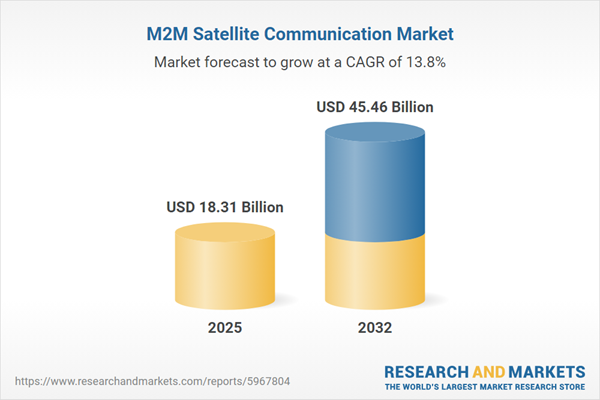Speak directly to the analyst to clarify any post sales queries you may have.
Machine-to-machine (M2M) satellite communication is becoming integral for enterprise connectivity in remote and infrastructure-deficient environments. As organizations expand digital operations and require seamless oversight of distributed assets, M2M satellite communication offers a robust solution for consistent, scalable connectivity across diverse geographies.
M2M Satellite Communication Market Snapshot
The global M2M satellite communication market is on a strong growth trajectory, projected to increase from USD 16.11 billion in 2024 to USD 18.31 billion by 2025, with a CAGR of 13.84%. Increased enterprise adoption is being driven by a need to address gaps in terrestrial infrastructure, particularly as organizations commit to digital transformation and operational continuity. M2M satellite solutions are central for stable asset management and strategic business resilience, ensuring uninterrupted workflows in physically and geographically challenging locations.
Scope & Segmentation of the M2M Satellite Communication Ecosystem
This report offers a comprehensive landscape view of the M2M satellite communication ecosystem, supporting informed strategic decisions in distributed operations:
- Industry Verticals: Agriculture employs M2M satellite systems for real-time crop oversight and yield optimization. Energy companies rely on satellite networks for system diagnostics and remote monitoring. Government and defense sectors require reliable, secure communication for emergency response. Logistics and transportation benefit from continuous asset tracking, improving supply chain visibility, while media and entertainment use satellite links to sustain uninterrupted content delivery for global audiences.
- Applications: Enterprises leverage M2M satellite communication to monitor remote assets, enforce safety and compliance, and achieve efficient fleet coordination. Satellite-enabled emergency communications maintain connectivity during network outages or unforeseen disruptions, critical for resilient operations.
- Platform Types: Deployment options include geostationary, low Earth orbit (LEO), and medium Earth orbit (MEO) satellites. These varied architectures accommodate requirements for uptime, latency, and extensive geographic coverage, matching specific operational priorities.
- Frequency Bands: Supported frequencies—C-band, Ka-band, Ku-band, and L-band—deliver resilient communication under adverse or remote conditions. The choice of frequency is essential for ensuring consistent, high-quality data transfer in any geography.
- Service Types: Available solutions range from IoT-optimized data channels and dedicated VSAT links to fully managed services and adaptable software platforms. Enterprises can select between turnkey deployments or tailored, customizable models based on operational scope.
- Regions Analyzed: The report covers key regions: Americas, Europe, Middle East, Africa, and Asia-Pacific. It includes analysis of region-specific regulatory frameworks, investment climates, and adoption trends to support risk assessment and expansion planning.
- Key Companies Profiled: Market leaders such as Inmarsat Global Limited, Iridium Communications Inc., ORBCOMM Inc., Globalstar, Thuraya, Intelsat, SES S.A., Eutelsat, Viasat, and Hughes Network Systems drive sector development with enterprise-focused connectivity and tailored service offerings.
M2M Satellite Communication: Key Takeaways for Leadership
- Low Earth orbit satellite expansion is elevating the quality and speed of operational analytics, enhancing decision-making for organizations with dispersed assets.
- Blending satellite and terrestrial connectivity allows a unified overview of asset status, supporting benchmarked risk management and process synchronization.
- Decentralized network architectures simplify scaling and support rapid market expansion, giving enterprises the flexibility to adjust connectivity as business objectives change.
- Tailored platform solutions, supported by collaborative relationships with vendors and partners, help address specific operational requirements for greater efficiency and adaptability.
- Addressing regulatory nuances and optimizing resource deployment across both mature and developing markets drive organizational growth while ensuring regulatory compliance and network capability.
Tariff Impact: Navigating Supply Chain and Cost Dynamics
- Shifts in US tariff policies prompt organizations to develop flexible procurement strategies for satellite equipment, managing expenditure and adapting to trade policies.
- Partnering with local manufacturers and diversifying the supplier base bolsters supply chain reliability and cost control, promoting sustainable network expansion.
- Developing robust domestic supply chains improves insulation against pricing volatility and supports the deployment of satellite communications to new international markets.
Methodology & Data Sources
The analytical foundation of this report includes independent research, review of current market trends, patent filings, regulatory developments, and direct input from sector experts. Each data source is verified for accuracy, ensuring decision-makers can rely on the report’s findings.
Why This Report Matters
- Equips senior decision-makers with strategies to enhance network resilience and respond to evolving market and compliance demands.
- Enables benchmarking of communications infrastructure, identification of operational risks, and proactive discovery of high-value opportunities across the global M2M satellite ecosystem.
- Delivers practical insights, supporting robust digital infrastructure planning and safeguarding business operations against future connectivity challenges.
Conclusion
M2M satellite communication provides enterprises with strategic connectivity solutions to strengthen operational reliability, advance modernization, and sustain uninterrupted business performance amid complex digital environments.
Additional Product Information:
- Purchase of this report includes 1 year online access with quarterly updates.
- This report can be updated on request. Please contact our Customer Experience team using the Ask a Question widget on our website.
Table of Contents
3. Executive Summary
4. Market Overview
7. Cumulative Impact of Artificial Intelligence 2025
Companies Mentioned
The companies profiled in this M2M Satellite Communication market report include:- Inmarsat Global Limited
- Iridium Communications Inc.
- ORBCOMM Inc.
- Globalstar, Inc.
- Thuraya Telecommunications Company
- Intelsat S.A.
- SES S.A.
- Eutelsat Communications S.A.
- Viasat, Inc.
- Hughes Network Systems, LLC
Table Information
| Report Attribute | Details |
|---|---|
| No. of Pages | 186 |
| Published | October 2025 |
| Forecast Period | 2025 - 2032 |
| Estimated Market Value ( USD | $ 18.31 Billion |
| Forecasted Market Value ( USD | $ 45.46 Billion |
| Compound Annual Growth Rate | 13.8% |
| Regions Covered | Global |
| No. of Companies Mentioned | 11 |









